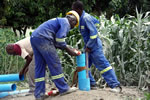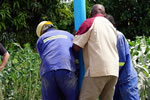
 The Technology Centre will conduct a Reverse Flow Borehole Hand-drilling Training Workshop in collaboration with a United States based engineering organisation running from 15th -26th May 2017.
The Technology Centre will conduct a Reverse Flow Borehole Hand-drilling Training Workshop in collaboration with a United States based engineering organisation running from 15th -26th May 2017.
A visiting team of 4 engineers including the inventor Mr Russell Crawford from the United States of America will conduct the workshop training and demonstrations on the Reverse Flow Borehole Hand-drilling technology at the HIT Campus. About 18 borehole samples will be drilled at various selected sites around the country during the demonstrations. HIT will be licensed to manufacture all the borehole hand-drilling kits including a compressor.
The Reverse Flow Borehole Hand-drilling technology is invented and patented by Mr Russell C. Crawford who will be leading the demonstrations. The technology can drill boreholes of 50 - 80 metres deep in one day and has been applied in India and in parts of the United States of America.
 The aim of these demonstrations is to promote low cost solution to safe groundwater access in Zimbabwe.
The aim of these demonstrations is to promote low cost solution to safe groundwater access in Zimbabwe.
The Reverse Flow Borehole Hand-drilling technology is a new method of drilling water wells by hand. The process uses the airlift reverse flow method and combines it with specially designed buoyant PVC pipe that can trap air and float in the excavation. The resulting method allows one to drill by hand large diameter holes to any depth without the use of heavy lifting devices. In effect the tool floats in the drilling fluid. The net lifting power of a 10' long drill tube is about 40 pounds. This makes possible large diameter holes, the use of down the hole hammers and the ability of the drill to float itself out of the borehole once drilling has ceased.
Hand drilling is also known as manual drilling, human powered drilling, and is sometimes referred to simply as low cost drilling. As the names suggest, hand-drilling technologies primarily utilise human energy.
 The cost of a manually drilled well can be 10% to 50% of machine drilled or hand dug well to similar depth. Hand drilling equipment can often be readily taken to sites which larger, more conventional drilling cannot access. Hand drilling techniques are extremely effective in appropriate ground conditions. They are not suitable beyond their hydrogeological limitations. In cases where the formation is too hard, or the water bearing formation too deep, conventional drilling is the preferred option.
The cost of a manually drilled well can be 10% to 50% of machine drilled or hand dug well to similar depth. Hand drilling equipment can often be readily taken to sites which larger, more conventional drilling cannot access. Hand drilling techniques are extremely effective in appropriate ground conditions. They are not suitable beyond their hydrogeological limitations. In cases where the formation is too hard, or the water bearing formation too deep, conventional drilling is the preferred option.
Unlike hand digging, which requires a person to be physically below the ground to dig the well (of at least one meter in diameter), hand drilling enables the operators to remain above the ground and drill a narrow diameter borehole (50 to 200mm). Hand drilling can provide highly affordable improved groundwater sources for households and communities for both domestic and productive use. Drilled depths depend on the technology and formation, but can extend to 30m and sometimes more.